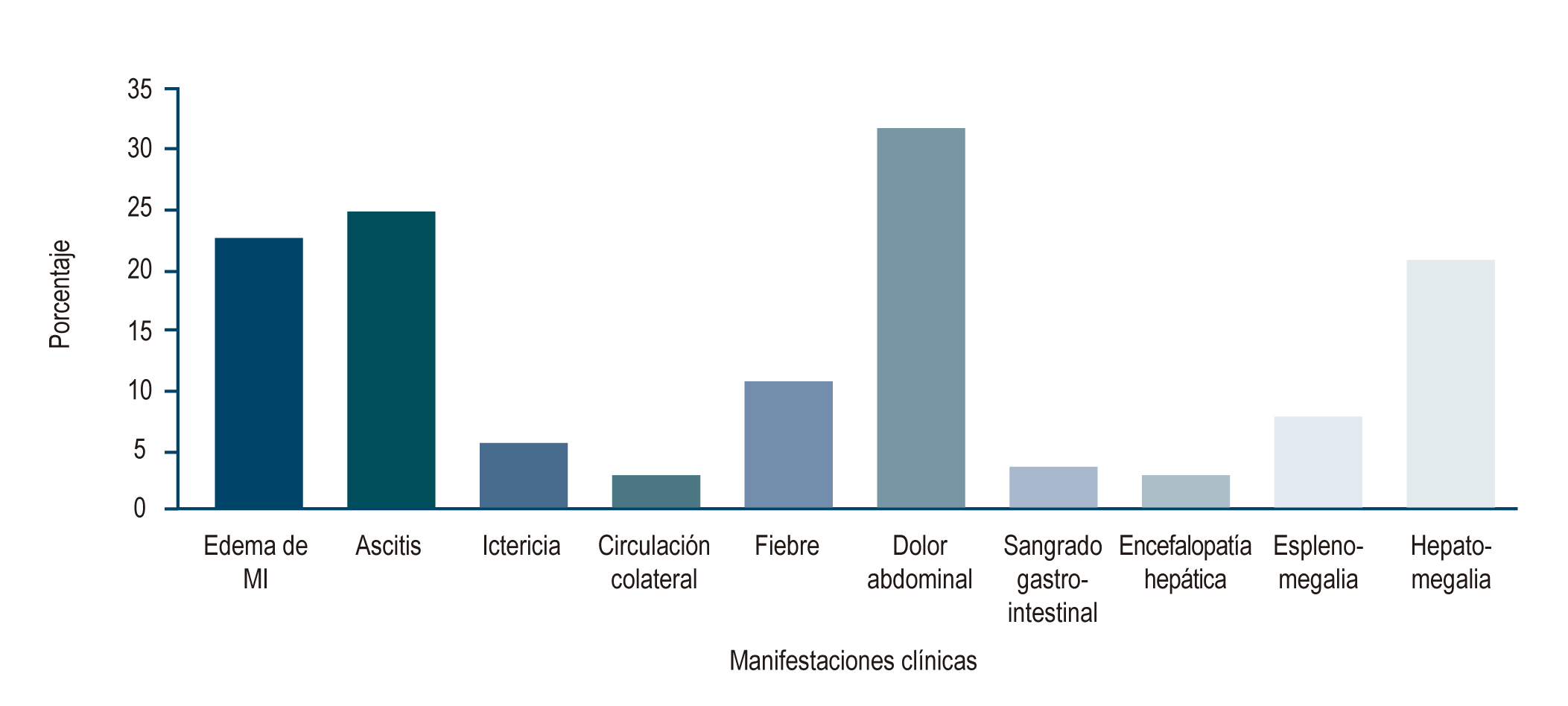Budd-Chiari Syndrome: Etiology, management, and outcomes in a study of 35 patients at the Hospital Pablo Tobón Uribe
DOI:
https://doi.org/10.22516/25007440.431Keywords:
Budd-Chiari Syndrome, Hepatic Vein Thrombosis, ThrombosisAbstract
Budd-Chiari syndrome (BCS) is a rare disorder characterized by the obstruction of the veins of the liver. Both its presentation and therapeutic management are heterogenous. The following is a retrospective study of patients diagnosed with BCS treated by the hepatology service at the Hospital Pablo Tobón Uribe. The results of the categorical variables are expressed as proportions and the continuous variables as means and ranges. The average age of onset of this disease was 37.7 years and it was not predominant in neither sex. The most common symptoms were abdominal pain (91.4%), ascites (71.4%) and hepatomegaly (60%). Out of 35 patients, 11 (31.4%) had primary hypercoagulability, 7 (20%) had some myeloproliferative disorder, 6 (17.1%) had extrahepatic malignancies —3 with mechanical compression and 3 due to associated hypercoagulability—, and 1 case had a membranous obstruction of the inferior vena cava. 32 patients (91.4%) received anticoagulation as first-line therapy and only 4 were taken to surgery: 2 to angioplasty, 1 to transjugular intrahepatic portosystemic shunt (TIPS) and 1 to orthotopic liver transplantation (OLT). On the other hand, 17 (48.5%) individuals underwent invasive procedures as a second-line therapy, of which 8 (22.8%) underwent angioplasty and stenting, 5 (14.29%) underwent TIPS and 4 needed OLT. The 6 patients who were taken to TIPS did not need liver transplants. Budd-Chiari syndrome remains a rare condition affecting the health of young men and women alike, with a heterogeneous clinical presentation but, in most cases, with a clear trigger where thrombophilic and myeloproliferative disorders predominate. The use of invasive therapeutic measures, especially the early selection of patients who may benefit from TIPS, has changed the natural course and prognosis of this group of patients.
Downloads
References
Valla DC. The diagnosis and management of the Budd-Chiari syndrome: consensus and controversies. Hepatology. 2003;38(4):793-803.
http://doi.org/10.1053/jhep.2003.50415
DeLeve LD, Valla DC, Garcia-Tsao G; American Association for the Study Liver Diseases. Vascular disorders of the liver. Hepatology. 2009;49(5):1729-1764.
http://doi.org/10.1002/hep.22772
Xue H, Li YC, Shakya P, Palikhe M, Jha RK. The role of intravascular intervention in the management of Budd-Chiari syndrome. Dig Dis Sci. 2010;55(9):2659-2663.
http://doi.org/10.1007/s10620-009-1087-7
Darwish Murad S, Plessier A, Hernandez-Guerra M, Fabris F, Eapen CE, Bahr MJ, Trebicka J, Morard I, Lasser L, Heller J, Hadengue A, Langlet P, Miranda H, Primignani M, Elias E, Leebeek FW, Rosendaal FR, Garcia-Pagan JC, Valla DC, Janssen HL; EN-Vie (European Network for Vascular Disorders of the Liver). Etiology, management, and outcome of the Budd-Chiari syndrome. Ann Intern Med. 2009;151(3):167-75.
http://doi.org/10.7326/0003-4819-151-3-200908040-00004
Ramírez AC, Correa S, Espinoza YP, Marín JI, Muñoz O, Santos O, Hoyos S, Guzmán C, Mena A, Restrepo JC. Síndrome de Budd Chiari: Reporte de tres casos y revisión de la literatura. Rev Col Gastroenterol. 2014;29(3):281-284.
Okuda H, Yamagata H, Obata H, Iwata H, Sasaki R, Imai F, Okudaira M, Ohbu M, Okuda K. Epidemiological and clinical features of Budd-Chiari syndrome in Japan. J Hepatol. 1995;22(1):1-9.
http://doi.org/10.1016/0168-8278(95)80252-5
Attwell A, Ludkowski M, Nash R, Kugelmas M. Treatment of Budd-Chiari syndrome in a Liver Transplant Unit, the role of transjugular intrahepatic porto-systemic shunt and liver transplantation. Aliment Pharmacol Ther. 2004;20(8):867-73.
https://doi.org/10.1111/j.1365-2036.2004.02190.x
Seijo S, Plessier A, Hoekstra J, Dell’era A, Mandair D, Rifai K, Trebicka J, Morard I, Lasser L, Abraldes JG, Darwish Murad S, Heller J, Hadengue A, Primignani M, Elias E, Janssen HL, Valla DC, Garcia-Pagan JC; European Network for Vascular Disorders of the Liver. Good long-term outcome of Budd-Chiari syndrome with a step-wise management. Hepatology. 2013;57(5):1962-8.
http://doi.org/10.1002/hep.26306
Qi X, Ren W, Wang Y, Guo X, Fan D. Survival and prognostic indicators of Budd-Chiari syndrome: A systematic review of 79 studies. Expert Rev Gastroenterol Hepatol. 2015;9(6):865-875.
https://doi.org/10.1586/17474124.2015.1024224
García-Pagán JC, Heydtmann M, Raffa S, Plessier A, Murad S, Fabris F, Vizzini G, Gonzales Abraldes J, Olliff S, Nicolini A, Luca A, Primignani M, Janssen HL, Valla D, Elias E, Bosch J; Budd-Chiari Syndrome-Transjugular Intrahepatic Portosystemic Shunt Group. TIPS for Budd-Chiari syndrome: long-term results and prognostics factors in 124 patients. Gastroenterology. 2008;135(3):808-15.

Downloads
Published
How to Cite
Issue
Section
License
Aquellos autores/as que tengan publicaciones con esta revista, aceptan los términos siguientes:
Los autores/as ceden sus derechos de autor y garantizarán a la revista el derecho de primera publicación de su obra, el cuál estará simultáneamente sujeto a la Licencia de reconocimiento de Creative Commons que permite a terceros compartir la obra siempre que se indique su autor y su primera publicación en esta revista.
Los contenidos están protegidos bajo una licencia de Creative Commons Reconocimiento-NoComercial-SinObraDerivada 4.0 Internacional.



















